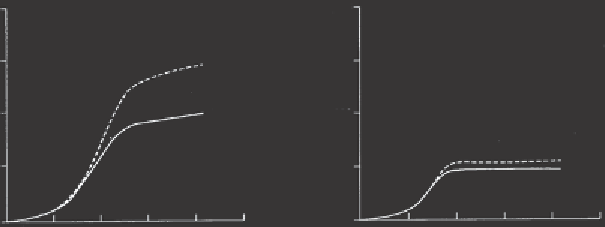Geoscience Reference
In-Depth Information
z
(cm)
z
(cm)
200
200
Light loam
Coarse sand
q
= 1 mm d
-1
q
= 2 mm d
-1
100
100
q
= 1 mm d
-1
q
= 2 mm d
-1
0
0
10
0
10
4
10
1
10
2
10
3
10
4
10
5
10
0
10
5
10
1
10
2
10
3
|
h
|
(cm)
|
h
|
(cm)
Figure 4.25
Soil water pressure head proiles of light loam and coarse sand at two
lux densities.
if the groundwater level is not more than 95 cm below the root zone. The amount
of 2 mm d
-2
is more or less the amount a crop needs to survive dry periods. Smaller
luxes can be transported over larger distances. At light loam soils drought damage
seldom occurs as these soils have favourable capillary rise properties and a large
water holding capacity. In coarse sand, capillary rise is rather limited: if the ground-
water level is more than 65 cm below the root zone, hardly any capillary rise will
occur. Also heavy clay (not shown) can transport only limited amounts of water. If the
groundwater level is more than 70 cm below the root zone in clay soils, the transport
will be insuficient to meet the water demand of crops in dry periods.
Question 4.16:
We want to calculate the amount of capillary rise in a loamy soil with
Eq. (
4.43
). The soil hydraulic functions can be described with the Van Genuchten param-
eters:
α
= 1.0 m
-1
,
n
= 1.40,
θ
res
= 0.00 m
3
m
-3
,
θ
sat
= 0.45 m
3
m
-3
,
K
sat
= 0.03 m d
-1
and
λ
= -1.0. Use a modelling tool (e.g., Excel) to make a graph similar to
Figure 4.25
.
4.10 Measurement of Soil Water Pressure Head
4.10.1 Piezometer
A piezometer is a tube of a few centimetres inner diameter with a permeable ilter at a
certain soil depth (
Figure 4.26
). If the ilter is below the groundwater table, a piezom-
eter is partially illed with water. The diameter of piezometer tubes is chosen such that
large that capillary rise and resistance to water low are negligible. As a result, any
variation in hydraulic head that may arise inside the piezometer is instantaneously
equalized. Thus, even if the soil pressure head at the ilter is changing rapidly, it can
be assumed that the hydraulic head inside the tube is uniform and equal to the hydrau-
lic head of the soil water at the ilter. Note that the pressure head inside the tube varies
with depth.

Search WWH ::

Custom Search